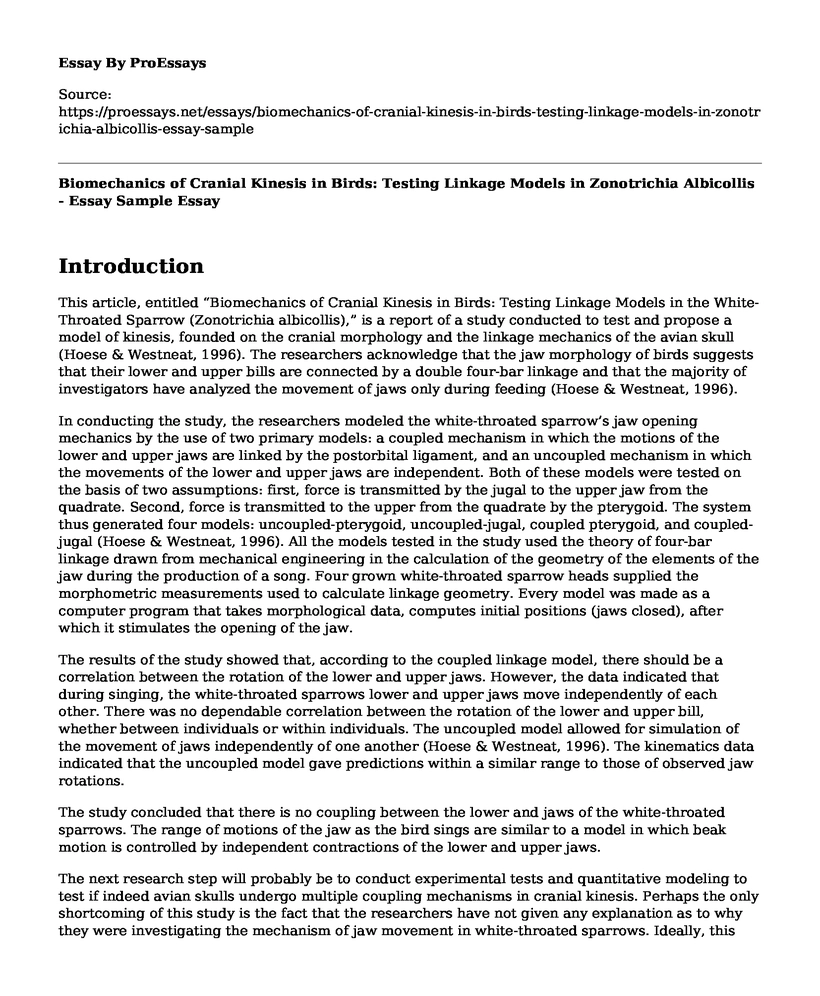Introduction
This article, entitled “Biomechanics of Cranial Kinesis in Birds: Testing Linkage Models in the White-Throated Sparrow (Zonotrichia albicollis),” is a report of a study conducted to test and propose a model of kinesis, founded on the cranial morphology and the linkage mechanics of the avian skull (Hoese & Westneat, 1996). The researchers acknowledge that the jaw morphology of birds suggests that their lower and upper bills are connected by a double four-bar linkage and that the majority of investigators have analyzed the movement of jaws only during feeding (Hoese & Westneat, 1996).
In conducting the study, the researchers modeled the white-throated sparrow’s jaw opening mechanics by the use of two primary models: a coupled mechanism in which the motions of the lower and upper jaws are linked by the postorbital ligament, and an uncoupled mechanism in which the movements of the lower and upper jaws are independent. Both of these models were tested on the basis of two assumptions: first, force is transmitted by the jugal to the upper jaw from the quadrate. Second, force is transmitted to the upper from the quadrate by the pterygoid. The system thus generated four models: uncoupled-pterygoid, uncoupled-jugal, coupled pterygoid, and coupled-jugal (Hoese & Westneat, 1996). All the models tested in the study used the theory of four-bar linkage drawn from mechanical engineering in the calculation of the geometry of the elements of the jaw during the production of a song. Four grown white-throated sparrow heads supplied the morphometric measurements used to calculate linkage geometry. Every model was made as a computer program that takes morphological data, computes initial positions (jaws closed), after which it stimulates the opening of the jaw.
The results of the study showed that, according to the coupled linkage model, there should be a correlation between the rotation of the lower and upper jaws. However, the data indicated that during singing, the white-throated sparrows lower and upper jaws move independently of each other. There was no dependable correlation between the rotation of the lower and upper bill, whether between individuals or within individuals. The uncoupled model allowed for simulation of the movement of jaws independently of one another (Hoese & Westneat, 1996). The kinematics data indicated that the uncoupled model gave predictions within a similar range to those of observed jaw rotations.
The study concluded that there is no coupling between the lower and jaws of the white-throated sparrows. The range of motions of the jaw as the bird sings are similar to a model in which beak motion is controlled by independent contractions of the lower and upper jaws.
The next research step will probably be to conduct experimental tests and quantitative modeling to test if indeed avian skulls undergo multiple coupling mechanisms in cranial kinesis. Perhaps the only shortcoming of this study is the fact that the researchers have not given any explanation as to why they were investigating the mechanism of jaw movement in white-throated sparrows. Ideally, this should have been part of the purpose of the study. Lack of this explanation, in essence, creates partial ambiguity (Samraj, 2018). In short, the purpose statement of the research is inadequate. Although it has produced new credible experimental knowledge, it leaves the reader wondering what the specific contribution or deliverable this study to the body of knowledge it presents is (Chen, 2017). Ideally, the purpose statement must fulfill the stated purpose, as it is on it that the design decisions ad research questions are driven (Chen, 2017).
References
Chen, S. (2017). Disciplinary variations in academic promotional writing: The case of statements of purpose. Functional Linguistics, 4(1), 4. https://link.springer.com/article/10.1186/s40554-017-0041-9
Samraj, B. (2018). Writing a Research Article. In The Palgrave Handbook of Applied Linguistics Research Methodology (pp. 199-219). Palgrave Macmillan, London. https://link.springer.com/chapter/10.1057/978-1-137-59900-1_10
Hoese, W. J., & Westneat, M. W. (1996). Biomechanics of cranial kinesis in birds: Testing linkage models in the whitethroated sparrow (Zonotrichia albicollis). Journal of Morphology, 227(3), 305-320. https://onlinelibrary.wiley.com/doi/abs/10.1002/(SICI)1097-4687(199603)227:3%3C305::AID-JMOR3%3E3.0.CO;2-4
Cite this page
Biomechanics of Cranial Kinesis in Birds: Testing Linkage Models in Zonotrichia Albicollis - Essay Sample. (2023, Aug 03). Retrieved from https://proessays.net/essays/biomechanics-of-cranial-kinesis-in-birds-testing-linkage-models-in-zonotrichia-albicollis-essay-sample
If you are the original author of this essay and no longer wish to have it published on the ProEssays website, please click below to request its removal:
- Paper Example on a Research Geneticist Career
- Essay Example on Human Cloning
- Anatomy and Physiology-Myocardial Infarction
- Major Attributes of the Portrayal of Nature in Wordsworth's Poetry Essay
- Exploring the Grand Canyon: Nature's Deepest Gorge - Essay Sample
- American Beaver: A Keystone Species of the US Animal Kingdom - Essay Sample
- Genetic Engineering in Food Production: Pros & Cons - Essay Sample







